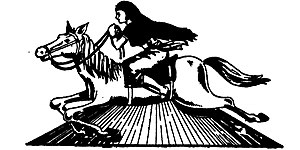Phou Ningthou
| Phou Ningthou | |
|---|---|
God of agriculture, crops, fertility, grains, harvesting, paddy, rice[1] | |
| Member of agricultural deities[1] | |
 The divine name "Phou Ningthou", written in archaic Meitei Mayek abugida | |
| Other names | Phouningthou |
| Affiliation | Meitei mythology (Manipuri mythology) and Meitei religion (Sanamahism) |
| Abodes | agricultural fields or granaries |
| Symbol | paddy plants |
| Texts | PuYas |
| Gender | Male |
| Region | Ancient Kangleipak (Antique Manipur) |
| Ethnic group | Meitei ethnicity |
| Festivals | Lai Haraoba |
| Consort | Phouoibi (Phouleima)[1] |
Phou Ningthou is a deity in Meitei mythology and religion (Sanamahism) of Ancient Kangleipak (Antique Manipur). He is the God and the divine male personification of the agriculture, crops, fertility, grains, harvesting, paddy, rice and wealth.[1][2] He is the consort of Phouoibi (Phouleima), the goddess of crops and agricultural fertility.[1][3][4][5][6]
Worship[edit | edit source]
Phou Ningthou is worshipped with Phouoibi, the goddess of rice. Farmers prayed to the two deities for a doubling of the previous year's yield, after the harvest.[1]
Phoukourol (Phoukouron or Phougourol or Phougouron) is a sacred hymn to call the spirit of the paddy. It is generally sung during harvesting.[7][8] It is done before the harvested crops are stored in the grain house.[9]
The Phou Kouba (calling the paddy/rice) ceremony is usually performed during mis-happenings to the farmers. Mis-happenings may be theft or burning of the paddy/rice, an animal like cow trespasses the threshing ground, etc. People perform the rites and rituals to induce the deity to stay at their places.[9]
Sareng fish (Wallago attu, helicopter catfish) with rice is the most important offering to the deity. It should be cooked with herbs and not with spices.[9]
References[edit | edit source]
- ↑ 1.0 1.1 1.2 1.3 1.4 1.5 Krishna, Nanditha (2014-05-15). Sacred Plants of India. Penguin UK. ISBN 978-93-5118-691-5.
- ↑ Hamilton, Roy W.; Ammayao, Aurora (2003). The Art of Rice: Spirit and Sustenance in Asia. UCLA Fowler Museum of Cultural History. ISBN 978-0-930741-98-3.
- ↑ Paniker, K. Ayyappa (1997). Medieval Indian Literature: Surveys and selections. Sahitya Akademi. ISBN 978-81-260-0365-5.
- ↑ Lairenlakpam Bino (2002). The Lois of Manipur: Andro, Khurkhul, Phayeng and Sekmai. Mittal Publications. ISBN 978-81-7099-849-5.
- ↑ Sanajaoba, Naorem (1993). Manipur: Treatise & Documents. Mittal Publications. ISBN 978-81-7099-399-5.
- ↑ Meitei, Sanjenbam Yaiphaba; Chaudhuri, Sarit K.; Arunkumar, M. C. (2020-11-25). The Cultural Heritage of Manipur. Routledge. ISBN 978-1-000-29637-2.
- ↑ Singh, Moirangthem Kirti (1993). Folk Culture of Manipur. Manas Publications. ISBN 978-81-7049-063-0.
- ↑ Singh, Ch Manihar (1996). A History of Manipuri Literature. Sahitya Akademi. ISBN 978-81-260-0086-9.
- ↑ 9.0 9.1 9.2 Parratt, Saroj Nalini (1980). Religion Of Manipur. Firma Klm. p. 93.
